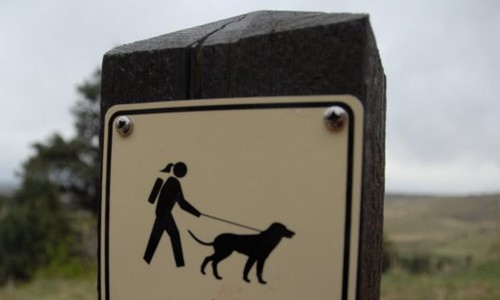Hiking with your dog

With dogs becoming more like family members these days, it is not surprising that people want to include them in outdoor activities. And although it is not always a good idea to mix pets and wilderness, it might be possible to take Fido along if you follow some simple precautions. Here are the basics to ensure a safe and happy time for both you and your dog:
Respect the rules - The first rule of taking dogs into wild or natural places is to respect the rules. Remember: it is not a right for your dog to be in the wilderness, it is a privilege. Do not jeopardize that privilege for yourself and others by ignoring prohibitions on dogs or leash restrictions. Always make sure you know the rules for the area you want to hike in. Dogs are not permitted on National Park or National Monument trails. National Forests may allow dogs on their trails, but there are exceptions, so check first. Dogs usually are allowed on wilderness area trails but, again, check to be sure.
Keep control - Keeping your dog on leash is a good idea at all times, even when it is not legally required. If you must let your dog off leash, be sure you have good voice command recall. That means you should be able to recall your dog even though a deer is running away from it. Likewise, you do not want your dog scaring horses or other hikers. You must be sure that you can control your dog even when it is leashed; some people own dogs that are stronger than they are. About leashes: a six-foot leash will give your dog enough room to tackle the trail without getting tangled up in underbrush or other hikers.
Health - Dogs are no different than people. They must be in shape before undertaking a strenuous hike. If you are not sure about your dog's fitness level, start off small and then work up to longer hikes. Make sure that all of your dog's vaccinations and medications are current, including rabies, bordatella, and heartworm. If you are hiking in an area with Lyme disease, ask your veterinarian about vaccinations.
Hydration - Staying hydrated is just as important for your dog as it is for you. In fact, because their body temperature is higher to begin with and they typically hike in a full fur coat, dogs are often quicker to overheat than people. Heat exhaustion and stroke can be fatal. It is up to you to bring a supply of clean water (drinking from ponds and streams is not any better for your dog than it is for you) and to make sure that your dog drinks often. Some people teach their dogs to drink from a squirt bottle. Others bring along a collapsible water dish. If you notice your dog running from shady spot to shady spot, panting excessively or becoming red in the gums, stop and cool him down. Gently pouring water on the stomach and groin area is a good technique. And do not forget that your dog needs to drink on cold days, too.
Packing - Dogs can carry their own weight on a hike, or at least part of it. A healthy dog ought to be able to carry up to one third of his weight in a special dog pack. Start with an empty pack full off shredded newspaper, though, to acclimate the dog to the pack before you gradually start adding weight on successive hikes. And do not put a pack on a dog on a hot, sunny day if there is a chance it will cause him to overheat faster.
Paws - If you are going to be hiking in an area with rough terrain, consider getting some dog booties to protect tender paws.
Post hike - After any hike, do a careful check for ticks and for any burrs or foxtails in your dog's coat. Foxtails can mean an expensive trip to the veterinarian if you let them get in your dog's nose or ears, so avoid hiking through areas with lots of them.
First aid - Part of your responsibility to your hiking companion is to be prepared for accidents. Some antibiotic cream is a good thing to have along for both you and your dog. Also, some Vet Wrap ® bandage tape (which sticks to itself but not to hair or skin) is a good thing to have along.
Join a group - Check to see whether there is a dog-friendly hiking group in your area. Some Sierra Club chapters have canine hiking groups; others allows pets along on some hikes but not others. Never show up for a hike with your dog unless you are certain he will be welcome (and legal).
Pack it out - It should not need to be said, but it is essential to pack out dog droppings rather than leaving them on the trail or even by the side of the trail. Dog waste is not the same as that of other animals, even that of coyotes or wolves. It is dangerous to the environment, especially near water sources, and it makes a bad impression on other hikers - not to mention their boots.
Credits - WorldwideRunning.com would like to thank the Sierra Club (www.sierraclub.org) for the authorization to reprint the article "Having Fun Outdoors with Your Dog". Text © 2008 Sierra Club. All Rights Reserved.
 | Running with your dog - A growing collection of articles for runners and walkers who love to bring their four-legged friends along. |
 | Hiking articles - In this collection of hiking articles you can learn all about hiking basics, skills and techniques, preparations, training, rules and etiquette, gear and equipment. |

